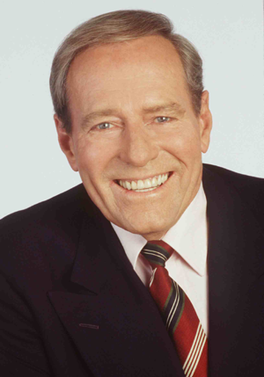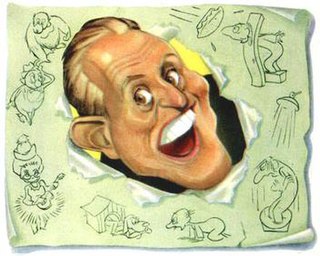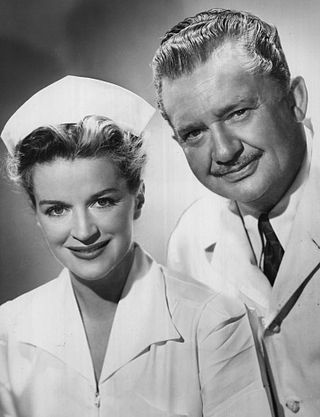Related Research Articles

Jean Pierre Carl Buron, known professionally as Jean Hersholt, was a Danish-American actor. He is most famous for starring on the CBS radio series Dr. Christian from 1937–1954, which later inspired a TV series with the same name from 1956-1957. He also co-starred with Shirley Temple in the film Heidi (1937). When asked how to pronounce his name, he told The Literary Digest, "in English her'sholt; in Danish, hairs'hult." From 1924 to 1955, he had 140 motion picture credits: 75 silent film and 65 "talkies"; he directed four.
The year 1956 in television involved some significant events. Below is a list of television-related events during 1956.
Broadcast syndication is the practice of content owners leasing the right to broadcast their content to other television stations or radio stations, without having an official broadcast network to air it on. It is common in the United States where broadcast programming is scheduled by television networks with local independent affiliates. Syndication is less widespread in the rest of the world, as most countries have centralized networks or television stations without local affiliates. Shows can be syndicated internationally, although this is less common.

The Disney Afternoon, sometimes abbreviated as TDA, was a created-for-syndication two-hour programming block of animated television series. It was produced by Walt Disney Television Animation and distributed through its syndication affiliate Buena Vista Television. Each show from the block has aired reruns on Disney Channel and Toon Disney. Disney Channel reaired four shows on "Block Party," a two-hour block that aired on weekdays in the late afternoon/early evening.

The Walt Disney Company has produced an anthology television series since 1954 under several titles and formats. The program's current title, The Wonderful World of Disney, was used from 1969 to 1979 and again from 1991 onward. The program moved among the Big Three television networks in its first four decades, but has aired on ABC since 1997 and Disney+ from 2020 to 2023.
The following is the 1959–60 network television schedule for the three major English language commercial broadcast networks in the United States. The schedule covers primetime hours from September 1959 through March 1960. The schedule is followed by a list per network of returning series, new series, and series cancelled after the 1958–59 season.

Philip Carey was an American actor, well-known for playing the role of Asa Buchanan on the soap opera One Life to Live for nearly three decades.

Father Knows Best is an American sitcom starring Robert Young, Jane Wyatt, Elinor Donahue, Billy Gray and Lauren Chapin. The series, which began on radio in 1949, aired as a television show for six seasons and 203 episodes. Created by Ed James, Father Knows Best follows the lives of the Andersons, a middle-class family living in the town of Springfield. The state in which Springfield is located is never specified, but it is generally accepted to be located in the Midwestern United States.
The following is the 1958–59 network television schedule for the four major English language commercial broadcast networks in the United States. The schedule covers primetime hours from September 1958 through March 1959. The schedule is followed by a list per network of returning series, new series, and series cancelled after the 1957–58 season.
The following is the 1957–58 network television schedule for the four major English language commercial broadcast networks in the United States. The schedule covers primetime hours from September 1957 through March 1958. The schedule is followed by a list per network of returning series, new series, and series cancelled after the 1956–57 season.
The 1955–56 network television schedule for the four major English language commercial broadcast networks in the United States. The schedule covers primetime hours from September 1955 through March 1956. The schedule is followed by a list per network of returning series, new series, and series cancelled after the 1954–55 season.

Warren Albert Stevens was an American stage, screen, and television actor.
The following is the 1956–57 network television schedule for the three major English language commercial broadcast networks in the United States. The schedule covers primetime hours from September 1956 through March 1957. The schedule is followed by a list per network of returning series, new series, and series cancelled after the 1955–56 season.

Ford Theatre, spelled Ford Theater for the original radio version and known, in full, as The Ford Television Theatre for the TV version, is a radio and television anthology series broadcast in the United States in the 1940s and 1950s. At various times the television series appeared on all three major television networks, while the radio version was broadcast on two separate networks and on two separate coasts. Ford Theatre was named for its sponsor, the Ford Motor Company, which had an earlier success with its concert music series, The Ford Sunday Evening Hour (1934–42).

People Are Funny is an American radio and television game show, created by John Guedel that ran from 1942 to 1960 in which contestants were asked to carry out stunts in order to prove that "People Are Funny." Many stunts lasted weeks, months, or even years; but those who were successful received prizes. People Are Funny rarely had celebrities, focusing instead on everyday people. As a result, few recordings of the show were saved.

Dr. Christian is a radio medical drama series with Jean Hersholt in the title role. It aired on the Columbia Broadcasting System from November 7, 1937 to January 6, 1954. Two years after the conclusion of the long-running radio program, the series was adapted for television on 1956 where it aired in syndication also through CBS on the Ziv Television production company until 1957, with a younger "Dr. Mark Christian" portrayed by Macdonald Carey as Dr. Paul's nephew.

A television show, TV program, or simply a TV show, is the general reference to any content produced for viewing on a television set that is traditionally broadcast via over-the-air, satellite, or cable. This includes content made by television broadcasters and content made for broadcasting by film production companies. It excludes breaking news, advertisements, or trailers that are typically placed between shows. Television shows are most often scheduled for broadcast well ahead of time and appear on electronic guides or other TV listings, but streaming services often make them available for viewing anytime. The content in a television show is produced by one of two production methodologies: live taped shows such as variety and news magazine shows shot on a television studio stage or sporting events The other production model includes animation and a variety of film productions ranging from movies to series. Shows not produced on a television studio stage are usually contracted or licensed to be made by appropriate production companies.
Children's programming has played a part in NBC's programming since its initial roots in television. This article outlines the history of children's television programming on NBC including the various blocks and notable programs that have aired throughout the television network's history on weekends.
Oxford Show was an Australian radio program which was broadcast on Melbourne station 3KZ in the 1950s. According to an article in the 4 April 1957 issue of The Age newspaper, It was a variety series hosted by Jim Berinson, a tenor. Also featured were Laurie Wilson, pianist-organist, and Hector McLennan, banjoist.

Richard Avonde (1914–1981) was a Canadian film actor who settled in the United States. He appeared in more than 50 films and television series.
References
- ↑ 1956-1957 United States network television schedule
- ↑ "GF Axing 'Lancers' At End of Season". Variety. February 13, 1957. p. 27. Retrieved June 1, 2023.
- ↑ "A Quick Look at the New Net Programs". Billboard. August 18, 1956. p. 30. Retrieved June 22, 2024.
- Brooks, Tim and Marsh, Earle, The Complete Directory to Prime Time Network and Cable TV Shows